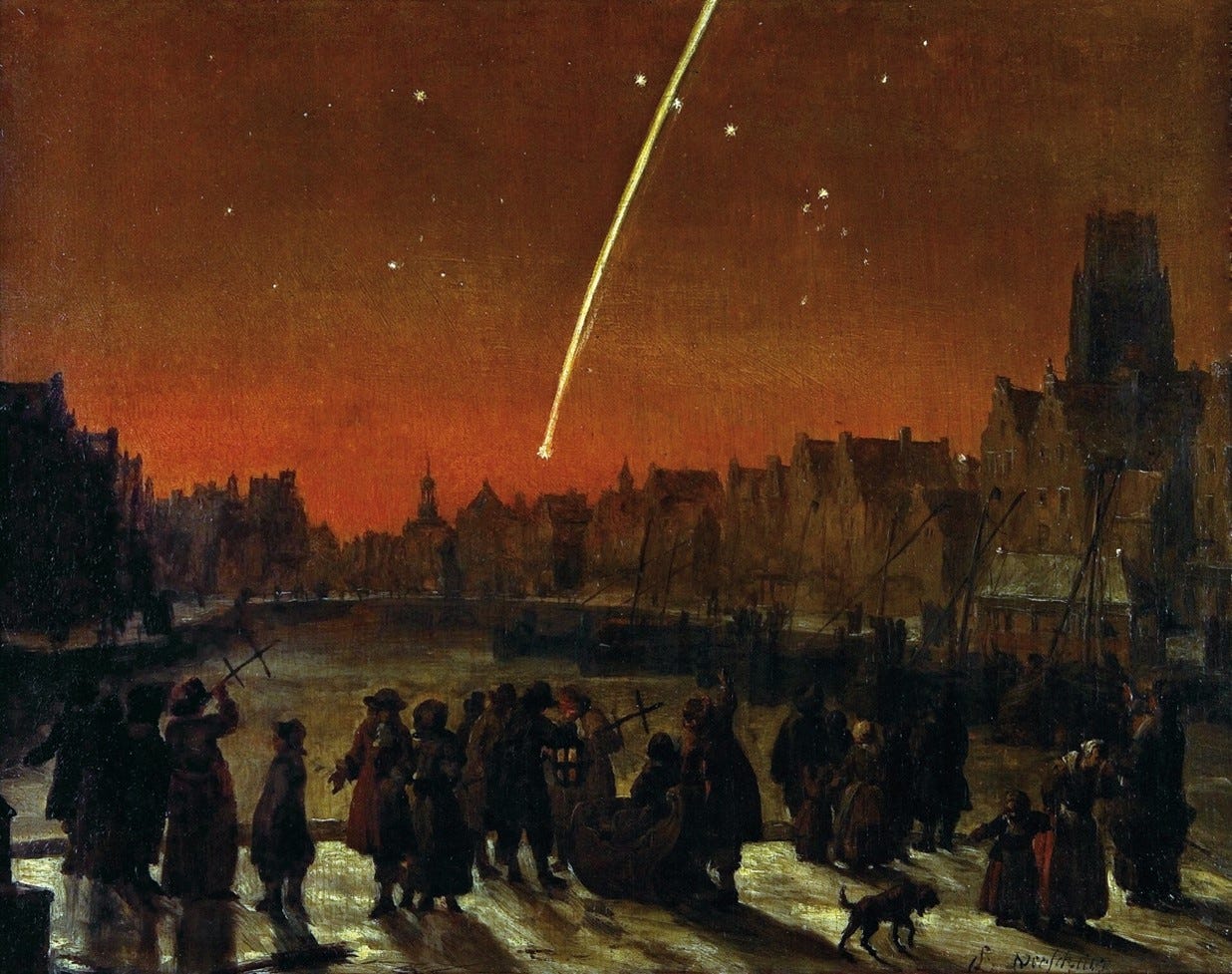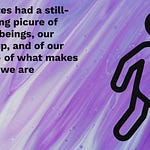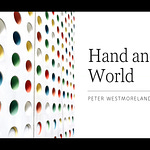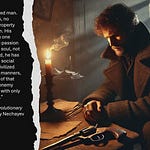Does science nurture or dispel our sense of wonder?
The piece that I play in the linked video is Chaconne la comète, by the French lute composer Jacques de Gallot (1625-1695). It is a musical rendition of the sighting of an unusually bright comet that passed across Europe and other parts of the world in the winter of 1680. This was Kirch's comet, also known as Newton's comet or the Great Comet of 1680. With its unusually long and bright tail (it could even be seen by day), it was greeted with a mix of awe and trepidation as comets were commonly regarded as harbingers of misfortune. Yet this comet was not unexpected. It was first spotted with a telescope, so people were warned ahead of time of its advent. They could come out and watch the heavens with their Jacob’s ladders, as this painting of the people of Rotterdam, The Netherlands, shows.
In the seventeenth century, comets could be predicted. Indeed, Newton used the observation and path of the comet to test and verify Kepler's laws, using data from the astronomer John Flamsteed. Comets and other phenomena concern a central question of my book Wonderstruck: does science dispel or nurture our sense of wonder?
Richard Dawkins argued that science is a source of wonder. It doesn’t “unweave the rainbow” as Keats wrote in Lamia. Rather, for Dawkins (1998, 17) “the spirit of wonder which led Blake to Christian mysticism, Keats to Arcadian myth and Yeats to Fenians and fairies, is the very same spirit that moves great scientists.”
I argue that relationship between science and wonder is a bit more complicated: it’s dynamic. Scientists aim to dispel our sense of wonder, but at the same time, their insights open new sources of wonder for us. In Wonderstruck, I focus on three cognitive technologies that harness wonder: magic, religion, and science. Of these three, science is most explicitly aimed at dispelling wonder. So, how can a human enterprise that aims to reduce our sense of wonder also be a source of wonder?
To answer this question, I turn to conceptual resources of early modern philosophy of the emotions. Moved by developments in theater (e.g., Shakespeare’s plays) and in political philosophy (e.g., Machiavelli’s theories of statecraft), philosophers became aware of the huge influence of emotions on our behavior. Emotions trump reality, as is clear in Romeo and Juliet’s double suicide, Othello’s jealous murder of his wife Desdemona, and in Machiavelli’s exhortation that a prince should not pursue virtue but rather the appearance of virtue to win popularity with the people.
Given this central role of emotions in our lives, what should we do with them? In contrast to popular perception of him as a rationalist with no attention for our affective lives, René Descartes provided a sophisticated answer to this question in his Passions of the Soul (1650). Even though he was a rationalist, he didn’t think emotions were useless or an obstacle to knowledge. He thought a proper control of the emotions is essential for gaining knowledge and for our happiness and wellbeing. In Passions, Descartes argues that wonder is the first of the passions. It is the first because it is what we experience when we encounter something for the first time, before we make a positive or negative evaluation of it (he distinguishes six basic emotions, or passions, from which all others are mixes. They include wonder, love, hate, desire, joy, and sadness.) As he writes:
Wonder is a sudden surprise of the soul which brings it to consider with attention the objects that seem to it unusual and extraordinary (PA 70, CSM I, 353).
For Descartes, wonder is a crucial emotion at the beginning of scientific inquiry. Without a disposition to wonder, you don’t have the drive that makes science possible. Wonder alerts you to gaps in your knowledge. It shows that you weren’t prepared for what you encountered. The philosopher Pierre Bayle took the 1680 comet as the starting point for his essay Various Thoughts on the Occasion of a Comet (1682). Contrary to what many people at the time believed, he argued that comets are not harbingers of misfortune. They are entirely natural phenomena, explicable by science.
To get to grips with strange phenomena such as comets, magnetism, and electricity, experimental philosophers of the seventeenth century began to focus on them, and not sweep them under the carpet as earlier natural philosophers had done in their explanations of the natural world. This was a central impetus to science. We can also see the interest in the bizarre in sixteenth- and seventeenth-century magical practices, alchemy, and in cabinets of curiosity or Wunderkammer. Initially, these cabinets were collections that a host of taste could show to their guests: fossils, artifacts, trinkets. Out of these motley collections grew the more orderly natural history museums, which attempted to categorize different artifacts and natural objects according to provenance, shape, or some other classification system.
Once things become understandable then your sense of wonder dissipates. Descartes thought wonder was useful at the beginning of enquiry but that it should not persist at the end of enquiry. Once you have found a way to explain a strange phenomenon, it’s inappropriate to keep on wondering at it. As Descartes cautions us, “although it is good to be born with some inclination to wonder, since it makes us disposed to acquire scientific knowledge, yet after acquiring such knowledge, we must attempt to free ourselves from this inclination as much as possible” (Passions 76, CSM I, 355).
However, Adam Smith, a philosopher who theorized about a century after Descartes about wonder in his History of Astronomy (posthumously published in 1795) thinks that scientific theories will not dispel our sense of wonder. Rather, as they help us to order and make sense of the world, they enable us to see anomalies. Smith offers the example of a naturalist who gazes at “a singular plant, or a singular fossil that is presented to him.” The fossil does not fit the naturalist’s classification scheme and is thus a source of wonder. By the time Smith wrote, scientists became increasingly aware of deep time and extinct species. The Scottish geologist James Hutton proposed the earth was far older than commonly held, and he was a member of Smith’s Edinburgh dining club, the Oyster Club. So Smith was aware of what fossils meant. You can only know that the fossil is anomalous by ordering the natural world. This quest seems open-ended. We do not wonder at comets anymore, but astrophysicists are now puzzled by dark matter, the matter in space that appears not to interact with light or the electromagnetic field. What is it? They have no answer yet. There is always more to discover.
Does science dispel our nurture our sense of wonder? The answer is: it does both. Scientists do have an enduring sense of wonder for the natural world they study, as I am discovering in qualitative experimental philosophical work I am currently conducting. But they aim to make the wondrous intelligible, and thereby it becomes less wondrous. Adam Smith likens nature to an opera-house: you at first see the performance and wonder at it. But then you look behind the scenes and you observe the mechanics, the ropes, pulleys and machines, that make gods appear on clouds. Nature, however, is much more complex than an opera-house, and much more opaque, which means there will always be new things to wonder at. The more we discover, the more new avenues for research are opened to us.

















Share this post